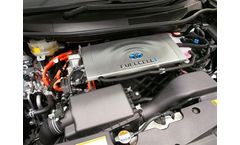fuel cell performance Articles
-
Fuel Cells Technology Promises Greener Future” Concludes Malaya Business Insight Upon Meeting GenCell CEO Rami Reshef
Malaya Business Insight Reporter Anton de los Reyes met with GenCell CEO Rami Reshef to learn about the launch of GenCell’s fuel cells in the Philippines. The article highlights the GenCell Remote IoT Manager, the software and app that allow remote control and monitoring of the equipment. Using the software allows users to track and optimize fuel cell performance in real-time and to receive ...
By GenCell Ltd
-
Different types of carbon nanotube-based anodes to improve microbial fuel cell performance
The microbial fuel cell (MFC) is an innovative technology for producing electricity directly from biodegradable organic matter using bacteria. Among all the influenceable factors, anode materials play a crucial role in electricity generation. Recently, carbon nanotubes (CNTs) have exhibited promising properties as electrode material due to their unique structural, and physical and chemical ...
-
Effect of various micro-porous layer preparation methods on the performance of a proton exchange membrane fuel cell
Proton exchange membrane fuel cells (PEMFCs) have been widely studied and discussed in the field of energy owing to their high energy efficiency and low waste emissions. A PEMFC uses hydrogen gas as a fuel, and works by causing hydrogen ions to link up with oxygen, producing liquid water as its sole by-product. The design of a PEMFC's micro-porous layer (MPL) can not only enhance cell ...
-
Influence of nitrogen limitation on performance of a microbial fuel cell
We describe the operation of a microbial fuel cell (MFC) system operating on a synthetic wastewater (acetic acid), under conditions of increasing nitrogen limitation. Two MFCs were operated under feed conditions which spanned a range of TKN/COD values of 1.6–28 mg/g. Stable operation was observed in all cases, even when no ammoniacal nitrogen was added to the cell. Improved electrochemical ...
-
Controlling methanogenesis and improving power production of microbial fuel cell by lauric acid dosing
Methanogens compete with anodophiles for substrate and thus reduce the power generation and coulombic efficiency (CE) of the microbial fuel cell (MFC). Performance of a baked clayware membrane MFC inoculated with mixed anaerobic sludge pretreated with lauric acid was investigated in order to enhance power recovery by controlling methanogenesis. In the presence of lauric acid pretreated ...
-
Performance assessment of a 5 kW SOFC cogeneration fuel cell
The performance of a 5 kW Solid Oxide Fuel Cell (SOFC) will be studied and described in this paper. This will help to significantly reduce residential Green House Gas (GHG) emission to about 20%, when compared with the actual emissions, based on the high-performance boiler and electricity produced by high-efficiency combined cycle. The particular benefit of SOFC, when compared with other ...
-
Towards an European Fuel Cell Strategy
Head of Unit 'Energy Consumption Technology' At the onset of the Fourth Framework Programme for Community research and technological development including demonstration, a ten year fuel cell strategy for Europe was published in 1995 jointly by DG XII (Directorate General for Science, Research and Development) and DG XVII (Directorate General for Energy). The interest of the European Community ...
-
Fuel cells - the environmentally friendly energy converter and power generator
Heat engines based on fossil fuel combustion produce harmful pollutant emissions. Environmental concerns and sustainable development call for new technology for energy conversion and power generation, which is more efficient, environmentally friendly and compatible with alternative fuels and renewable energy sources and carriers. Fuel cells meet all these requirements and are being rapidly ...
-
Using TGA-MS to Explore Novel Hydrogen Carriers for Fuel Cells
Hydrogen (H2) production is pivotal in the global shift towards a net-zero carbon economy. Its elemental abundance and zero-emission combustion position it as an ideal renewable energy source. However, the journey to harness hydrogen’s full potential is fraught with challenges, particularly in storage and transportation. Researching viable hydrogen carriers is critical, as conventional ...
-
Performance of microbial fuel cells on removal of metronidazole
The microbial fuel cells (MFCs) are the focus of extensive investigation as one of the promising technologies for renewable energy generation and wastewater treatment. Two-chambered MFCs were designed to investigate the removal of metronidazole and to quantify the effect of antibiotic on the efficacy of energy generation. Using 1,000 mg glucose L−1 containing different concentrations of ...
-
Effect of operating temperature on performance of microbial fuel cell
The performance of dual chambered mediator-less microbial fuel cell (MFC) operated under batch mode was evaluated under different operating temperatures, ranging between 20 and 55 °C, with step increase in temperature of 5 °C. Synthetic wastewater with sucrose as carbon source having chemical oxygen demand (COD) of 519–555 mg/L was used in the study. Temperature was a crucial factor in the ...
-
Classification and comparison of interfacing schemes for connecting fuel cells to a single-phase utility line
Based on a systematic classification of dc source to utility interfacing schemes, this paper presents six major interfacing schemes for connecting fuel cells to a single-phase utility line using high-frequency transformer isolated power converters. The operation, advantages and disadvantages are discussed for each scheme with examples and operating waveforms. Several features e.g., utility line ...
-
Application of power electronics with the US DOE distributed generation programme
Power electronics play an important role in achieving affordable, highly fuel-efficient fuel cell power generation plants and will enable the US Department of Energy's Office of Fossil Energy Fuel Cells programme to achieve higher national goals: environmental, economic and energy security. The initial focus on power electronics has been to understand the interactions between the SOFC stack, the ...
-
A two-stage power electronic interface for fuel cell-based power supply system
The increasing energy demands, insufficient availability of power generation and increasing global environmental problems, need alternate/green power sources. Among the different green power technologies such as wind power, photovoltaic, gas turbine and fuel cell, the fuel cell-based distributed generation is considered as one of the most promising solutions for stand-alone/grid applications due ...
-
The effects of electrode spacing on the performance of microbial fuel cells under different substrate concentrations
In this study, the electricity generation and organic removal in microbial fuel cells (MFCs) were examined for electrode spacing (ES) covering 5.8, 10.2, 15.1, and 19.5 cm, and for each ES the MFCs were discharged with a series of influent substrates (CODin). Results indicate that organic removal was related to CODin but not to ES. Best chemical oxygen demand (COD) removals of ...
-
Gas Analysis in Renewable Energy Development
Introduction to Gas Analysis and Renewable Energy The world stands on the precipice of an energy revolution. As we stride forward, the interplay between gas analysis and the burgeoning renewable energy sector is becoming ever more pronounced. This article delves deep into why gas analysis is essential, how it’s performed, and the integral role Cambridge Sensotec plays in this domain. The ...
-
Energy storage implementation to reach carbon neutrality
Summary The massive deployment of intermittent renewables to achieve the decarbonization targets set out in Paris Agreement by 2050, is arising power management concerns while integrating with the power system due to the variability and intermittency of their renewable energy sources. The implementation of energy storage systems will lead to more efficient energy management system since the ...
-
Membrane Electrode Assembly (MEA) Activation Procedures
Why is an activation procedure or break-in necessary for a membrane electrode assembly (MEA)? A large reason for performing an activation procedure or break-in is to properly humidify the membrane portion of the MEA that was dried out during the hot press stage of the membrane electrode assembly(MEA) production. MEAs will not work well when they are not fully humidified (see article: Why is ...
Need help finding the right suppliers? Try XPRT Sourcing. Let the XPRTs do the work for you



